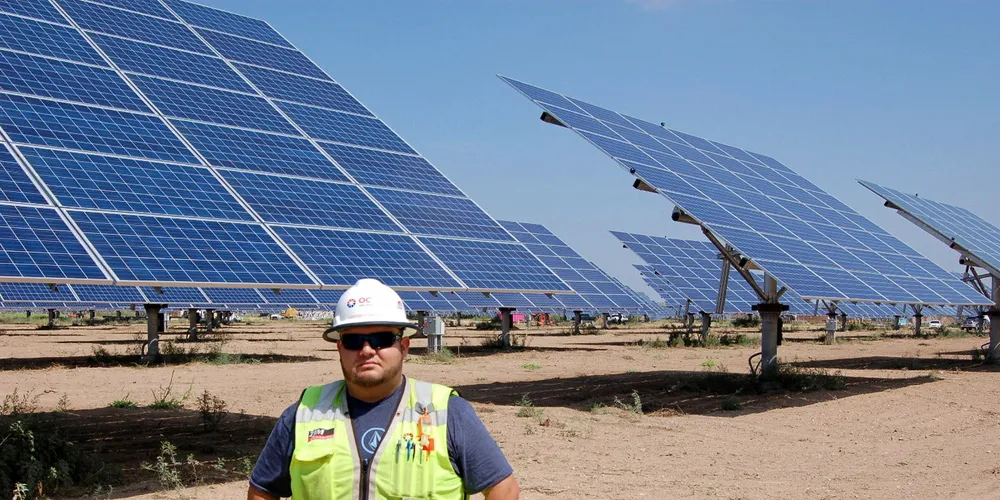US Q2 solar installs tumble 12% on supply issues as market readies for 2023 rebound: SEIA
The industry faces a challenging next six months before the new federal climate law will supercharge development through 2027

US solar installations fell 12% in the second quarter amid ongoing supply chain constraints, while the new federal climate law will be a “massive growth catalyst” for the industry from 2023 through 2027, according to a new report by Wood Mackenzie (WoodMac) and the Solar Energy Industries Association (SEIA).
The constraints resulted from a Department of Commerce (DoC) probe into whether Chinese companies were avoiding US tariffs through new factories in Southeast Asia and the Uyghur Forced Labour Prevention Act (UFLPA) taking effect in June, underscoring the industry’s overreliance on foreign suppliers.
WoodMac now forecasts 15.7GW of US installations this year on a direct current basis, the lowest since 2019, and a sharp decline from a record 23.6GW in 2021.
“Just in the last quarter, this has led to a 10GW reduction to the total pipeline of 2022 utility-scale projects either under construction or in development as projects are delayed to 2023 and 2024,” they added.
New second quarter capacity totaled 4.6GW with the utility segment accounting for 2.7GW, a 25% decrease from a year earlier. Residential solar installations set a quarterly record with 1.4GW, up 37% from a year earlier, while commercial solar fell 7% to 336MW.
First half total installations were 4.9GW versus 7.8GW in the same 2021 period, according to the report.
Despite the decline, solar accounted for 39% of new US electricity generating capacity additions through June versus wind (28%), natural gas (26%), and others (7%), down from a leading 44% a year earlier.
WoodMac forecasts 8.1GW of utility installations this year, the lowest annual total since 2018, versus a record 17GW in 2021.
The report notes that the utility-scale segment has experienced a “true solar coaster over the last several months.”
DoC launched its investigation in March. The looming threat of retroactive tariffs up to 250% on crystalline silicon solar panels from Cambodia, Malaysia, Thailand, and Vietnam – which sourced 80% of those installed here last year – squeezed the supply chain and put US businesses at risk of owing large penalties should the probe conclude imports from there violated US tariff law.
That possibility led developers to postpone or cancel a significant number of solar projects planned for construction in 2021 and this year.
Then, in early June, President Joe Biden issued an executive order declaring a 24-month tariff moratorium on modules manufactured in those four nations before DoC could complete its inquiry. A preliminary decision is expected in late November.
While companies may be subject to tariffs when the 24-month period ends, they would not have to pay any retroactive tariffs. The report assumes no additional tariffs are implemented.
“But if they were, already high module prices would increase further, exacerbating and prolonging supply constraints,” the researchers said.
The report notes that Biden’s action has allowed developers to restart activities and Southeast Asian manufacturers could resume module deliveries to the US. Still, the supply situation is not normalised.
Meanwhile, US Customs is stepping up enforcement of UFLPA that addresses alleged human rights abuses in China’s Xinjiang region, a major supply source for polysilicon, cells, and other critical components in solar panels.
Customs began using so-called withhold-release orders (WROs) to detain products thought to contain polysilicon from Xinjiang. The agency later began asking for documentation that quartzite, a key ingredient of polysilicon, was not mined in the region.
While the presumption that any product using any inputs from Xinjiang benefited from forced labor is rebuttable, the process for doing this can take weeks, even months, with more than 3GW of panels in mid-August said to be languishing in warehouses.
The report notes that all this has exacerbated ongoing supply chain challenges.
Starting in 2023, the industry’s fortunes are set to rebound as the new climate law will be a “massive growth catalyst”, according to the report.
“The Inflation Reduction Act has given the solar industry the most long-term certainty it has ever had,” said Michelle Davis, principal analyst at Wood Mackenzie and lead author of the report.
“Ten years of investment tax credits stands in stark contrast to the one-, two-, or five-year extensions that the industry has experienced in the last decade. It’s not an overstatement to say that the IRA will lead to a new era for the US solar industry,” she added.
The report forecasts the law will help the US solar market grow 40% over baseline projects through 2027. The utility-scale sector will lead growth with 162GW of new capacity and cumulative installations across all market segments will nearly triple in size from 129GW today to 336GW within five years.
This rosy outlook assumes a massive nationwide pipeline of projects are permitted and can obtain grid interconnections within reasonable periods of time, which has not occurred in many cases in regions rich in solar resource. The climate law does not include permitting reforms or a tax credit for long-haul transmission.
(Copyright)